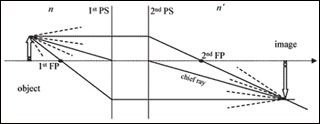
Imaging condition: ray-tracing. (Image by Prof. George Barbastathis.)
Instructor(s)
Prof. George Barbastathis
Prof. Colin Sheppard
Dr. Se Baek Oh
MIT Course Number
2.71 / 2.710
As Taught In
Spring 2009
Level
Undergraduate / Graduate
Course Description
Course Features
- Video lectures
- Lecture notes
- Projects and examples
- Assignments: problem sets with solutions
- Exams and solutions
Course Description
This course provides an introduction to optical science with elementary engineering applications. Topics covered in geometrical optics include: ray-tracing, aberrations, lens design, apertures and stops, radiometry and photometry. Topics covered in wave optics include: basic electrodynamics, polarization, interference, wave-guiding, Fresnel and Fraunhofer diffraction, image formation, resolution, space-bandwidth product. Analytical and numerical tools used in optical design are emphasized. Graduate students are required to complete assignments with stronger analytical content, and an advanced design project.
Other Versions
Other OCW Versions
The different OCW versions of this subject provide complementary materials, including lecture videos, detailed lecture and recitation notes, homework and exam problems with solutions, and student projects.Archived versions: ![]()


